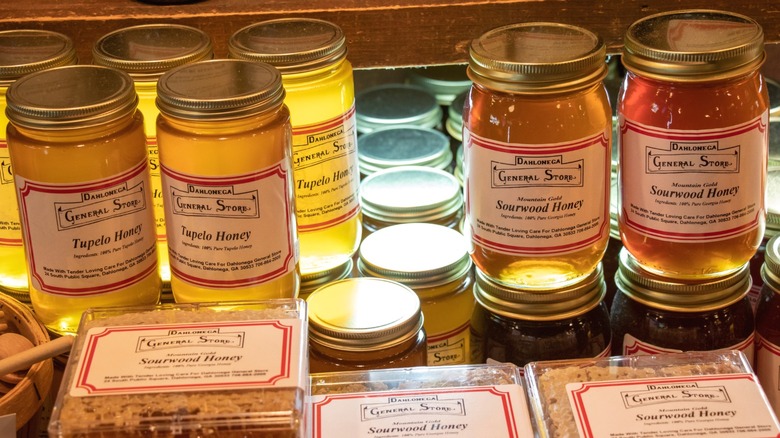Why Tupelo Honey Is So Expensive
If you've ever seen jars of tupelo honey for sale someplace, you might have asked yourself two questions: "Why did they name a honey after Elvis' birthplace?" and "Why is it so expensive?" Well, it's not actually named after the city of Tupelo, Mississippi. In fact, Tupelo is named after the source of the honey: the flowers of the tupelo tree, which make an exceptionally sweet, buttery variety of honey. Chances are you've heard of it courtesy of Van Morrison, who wrote a beautiful song called "Tupelo Honey", back when he still wrote beautiful songs and didn't just complain about COVID lockdowns, or the 1997 film "Ulee's Gold," which earned Peter Fonda an Oscar nomination. But the other question remains: Why is tupelo honey so darn expensive? Well, it's a matter of simple economics. Due to a number of reasons, the demand for the honey far exceeds the supply.
While a 12-ounce jar of Good and Gather clover honey (much more common than tupelo honey) will only cost you about four bucks, a jar of tupelo honey the same size will cost you nearly thirty dollars. It's not as expensive as other kinds of rare honey, including the fabled purple honey of the North Carolina Sandhills or the hallucinatory "mad honey" of the Himalayas, but it's still pretty pricey. The reasons why have to do with the blooming period of tupelo flowers, as well as the habitat of tupelo trees.
It's really, really hard to harvest tupelo honey
There are two things about tupelo trees that give headaches to beekeepers looking for some of that sweet, sweet tupelo honey cash. The first is that tupelo flowers only bloom for a few weeks a year, around late April and early May. That gives beekeepers a limited window in order to get their bees as much tupelo nectar as possible, which leads into the next problem. Tupelo trees mainly grow in swamps, and swamps are, for many different reasons, not ideal for beekeeping.
Bees have a reputation for being hard workers, but they serve the hive, not the beekeeper. They want to get as much nectar in an efficient manner as possible, which means they're not going to go out of their way to visit a tupelo tree unless one happens to be in the area. The good news is that once they are in the area, they will pass up other flowers in order to visit the tupelo. The bad news is that in order to be in the area, beekeepers have to get creative, putting their hives on barges or up in trees. And that's not even going into the copious amounts of mosquito pesticide that can wreck a whole colony of bees if they're not careful. Despite all that, though, the taste is well worth it, whether drizzled on tomato sandwiches or added to fried chicken.

